
By Mark Shainblum
Once upon a time, in more leisurely world where dads wore hats and moms wore aprons, shopping for food really meant shopping for ingredients. The food industry, such as it was, was a provider of primary products like flour, shortening, milk, meat, fruit, vegetables, eggs and spices: Not meals, but the stuff you’d make meals from.
The vast majority of women still worked – and cooked – at home, and consumer expectations of the food industry were relatively modest. In those days, “ready to eat” meant an apple or a banana, or perhaps a box of Corn Flakes. Terms like “microwaveable,” “organic,” “low fat” and “pizza pocket,” had not yet been coined, and the field of food science as it is known today did not yet exist.
At the time, and even well into the era of early convenience foods like frozen TV dinners, toaster pastries and instant drink crystals, the captains of the food industry called on scientists primarily to improve their methods of production, explains Dr. Inteaz Alli, a professor in the Department of Food Science and Agricultural Chemistry at Macdonald Campus.
“Food companies mostly hired engineers and chemists who were much more focused on the processing technology than on the end product,” he says. “Obviously, consumer needs and expectations have changed considerably since then, and the focus has not only shifted, it has extended.”
“For the last 20 or 30 years at least, the industry had been demanding qualified food scientists,” says Dr. Selim Kermasha, current chair of the department. “A chemist or microbiologist alone cannot do the job. Food science is a multidisciplinary field that covers all the areas related to food: Chemistry, microbiology, biology, physics, engineering and even marketing.”
While food scientists are still very concerned with processing technology, Alli adds, the end product is now the star of the show. “Traditional expectations about food quality and safety are now compounded by newer societal expectations. Many consumers now demand convenient, environmentally friendly, organic foods free from genetically modified organisms. That’s a complex set of expectations.”
Alli, who graduated from McGill’s Department of Chemistry in the mid-1970s was drawn into the food science field when he went to work for a sugar cane grower in Guyana. “That was my introduction to the workplace and the food industry. A lot of my early learning is based on that experience.”
The food scientist plays an important balancing role in the industry, he goes on to explain.
“We try to foster the use of new technologies, new processes and new products based on the needs of consumers and society as a whole,” he says. “But we know there are limitations in addressing sometimes contradictory needs. For instance, the less we process food, the greater the risk of food safety issues coming up. On the other hand, we can process food to make it completely safe, but then we lose a lot of the important quality, sensory and even nutritional attributes. The consumer simply wouldn’t be able to eat it.”
In our recent era of free trade agreements and a food industry that is rapidly consolidating down to a small number of huge plants, the food scientist has an important role to play, Dr. Alli says, especially in the wake of a number of food safety scares like the listeriosis outbreaks in the packaged meat and cheese industries
“It shouldn’t matter whether there are a dozen small plants or one big plant serving the whole country,” he says. “Food should be safe regardless of the number of facilities. Now of course, the magnitude of the problem and the distribution issues introduce some additional food safety challenges. That’s especially true of temperature-sensitive products like cheeses. The food scientist must now extend those food safety requirements not only to the manufacturing end, but also at the distribution and retail end. We need to ensure the integrity of the entire food chain all the way to the consumer.”
Sidebar: Good taste, good food, great science
It’s not hard to hear the pride in Dr. Selim Kermasha’s voice as he describes the changes his department has gone through in the last few years. Chair of the Department of Food Science and Agricultural Chemistry at McGill’s Macdonald Campus for just over two years, Kermasha has overseen a major renewal of course offerings and the addition of an MSc program, a one-year certificate program in food science for students who already have a bachelor’s degree in a related discipline, and soon, a certificate program in food safety.
“Three years ago, we had about seven students per year entering the program,” he says. “In the best year in our history we had perhaps 15. Last year we had 28, and this year, in September alone we had about 30, which I am quite sure will go up to 40 with January admissions. Give that a program lasts three years, my expectation is that by next year we will have over 100 students in the department.”
One of the major factors fueling the department’s growth, he says, is the quality of its programs and the practical, real-world opportunities it offers students when they graduate. In particular, McGill is accredited by the U.S.-based Institute of Food Technologists (IFT), which opens numerous employment opportunities for graduates in the U.S.
“We train students across a wide range of disciplines, including chemistry, biochemistry, microbiology, engineering, food safety and marketing to prepare them for a broad range of careers,” he says. “Our graduates have the clear potential to become industry professionals and leaders, even with an undergraduate degree. This is a very important issue, because some degrees will leave you stuck in the corner of a lab somewhere for 20 years.”
